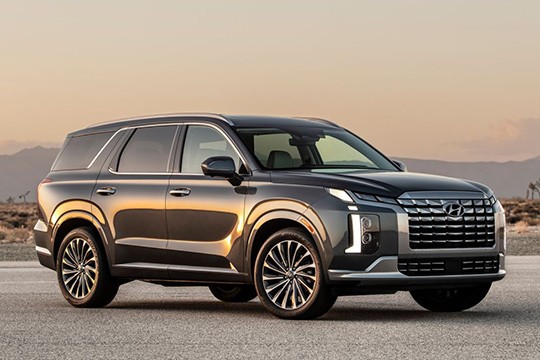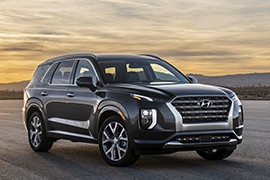HYUNDAI Palisade Models/Series Timeline, Specifications & Photos
First production year: 2019
Engines: Gasoline, Diesel
Body style: SUV (Sports Utility Vehicle)
Hyundai's flagship SUV, the Palisade, received an upgrade in 2022 and improved the vehicle both on the inside and the outside.
When Hyundai unveiled the Palisade at the 2018 Los Angeles Auto Show, it offered a feasible alternative to other premium SUVs, at least in terms of features and amenities. But the carmaker didn't stop, and in the first half of 2022, it released a facelifted version, which came with improvements in most areas. Yet, the overall shape was still the same.
At the front, the grille was wider and sported a cascading design, as they put it. However, its five horizontal slats and the chromed elements that adorned the front fascia, and the reshaped vertical headlights offered more of an Escalade-like appearance. At the back, the bumper got a new design, with a red stripe crossing it from left to right, above the silver-painted underbody shield.
Inside, Hyundai stepped up its game, and the third row offered heating for passengers, a first for the Korean carmaker. Moreover, the second row provided heated and ventilated seats for enhanced comfort. But the carmaker didn't focus only on comfort but also enhanced the safety by offering nine airbags fitted as standard, as compared to seven for its predecessor.
Under the hood, Hyundai installed the same 3.8-liter V6 engine that ran in Atkinson Cycle mode for improved fuel efficiency and was paired to the same eight-speed automatic gearbox. Unlike its predecessor, though, it provided a Tow Mode for the electronically controlled all-wheel drive system.
The Palisade was introduced at the 2018 Los Angeles Auto Show and it was the most luxurious SUV in the Hyundai stable. It shared its platform with the Kia Telluride.
Hyundai increased its market share over the years and it started to upscale its models. There is a long way from the ugly little Tucson to the luxurious, three-row, Palisade. It was built to compete with vehicles such as Honda Pilot, Nissan Pathfinder, and Ford Explorer. Its predecessor was the Hyundai SantaFe XL.
From the outside, it looked very strange with its vertical headlights and extended daytime running lights. It was something saw on the Cadillac Escalade, but the Palisade made it with rounded lines, instead of sharper ones. The long vehicle featured chromed lines around the door's windows, and the roof looked disconnected from the rest of the car, from the C-pillar.
Inside, the Palisade was available with up to eight seats, if a bench was fitted in the middle row. If captain seats were chosen then it offered only seven. On the center console, the gearshift lever was replaced by buttons, leaving more room for elbows and a big storage compartment underneath. The optional 10.25” touch-screen infotainment system was equipped with a Harman Kardon stereo.
The Palisade was equipped with an all-wheel-drive system controlled via a rotary knob on the center console, similar to the one found in a Land Rover. It offered several programs for traction, but it didn't feature a low-range gear. Despite its size, the most luxurious Hyundai SUV was available as a front-wheel-drive only version. Power came from a standard 3.5-liter V6 engine mated to an 8-speed automatic gearbox. Depending on the market, also it was offered with a 2.2-liter diesel engine.

